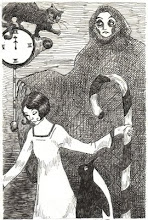
Modern Life: Edward Hopper and His Time is up at The Whitney only through the 10th, so run people, run!
Inamorato and I finally got uptown to see it this past Saturday. I love Edward Hopper. I've used the sentence, "I want it to look like a Hopper painting" when talking to lighting and costume designers far too often. I've featured him briefly in this gathering of pixels before. Jewel tones, saturated colors, warm, yet theatrical lighting. Beautiful. Some people might remember the battle of the beige sweater. Twelve or so years ago I collaborated on the stage adaptation of Cigarette Waltz by Philip-Dimitri Galas (under the title Angry Little People). My collaborator wore a green Mad Men era dress that originally belonged to my mother, and she was admittedly, maybe a little too young for the role. So she added a beige sweater to her costume to make it just a little less cute. I seem to remember endless circular arguments about how that damn sweater was messing with my Hopper-like pallet. But the beige sweater remained.
Back to the Whitney. Like I said, I'm a little obsessed with Hopper and my only beef with the exhibit is that I wanted a little more Hopper in my Hopper exhibit. Which is likely more my problem than the Whitney's, as the exhibit as whole was extremely enjoyable. They put Hopper and his work in the context of the times he painted in (most famously between the wars, though his career began in the aughts and lasted through the sixties), the painters who came before him (Ashcan) and those who painted along side him.
Most exciting to me of the non-Hopper work were the early 20th century paintings of the insides of theaters, including the one by William Glackens at left of Hammerstein's Roof Garden and one of an unidentified performer lit only by footlights. As one enters the exhibit, one is greeted by a thrilling 1921 film of skyscrapers, hundreds of identically dressed men in hats and ties disembarking from the Staten Island Ferry, downtown Manhattan shot from way up high, the people all looking like Harry Lime's ants. It truly was The Machine Age and it looked just like Frans Masereel's The City.
I looked at all this work from early in the last century and it finally dawned on me: the Twentieth Century is truly over. You know how the feel of the previous century kind of sticks around for a few years? Kind of like a hangover. How the 20th century didn't really start until the teens? Well, the 20th Century hangover has ended. A new era is upon us. The Machine Age, like the Age of Reason and the Iron age before it has been consigned to the dust pile. All hail the glorious future!


















No comments:
Post a Comment